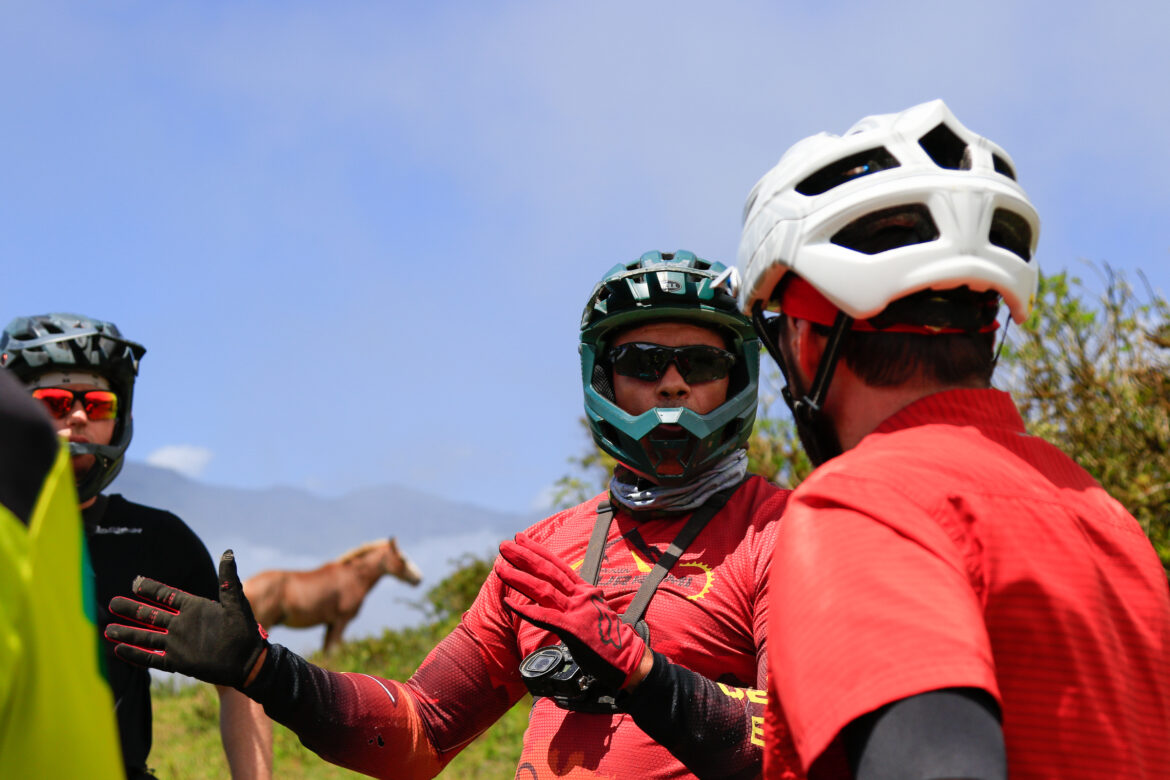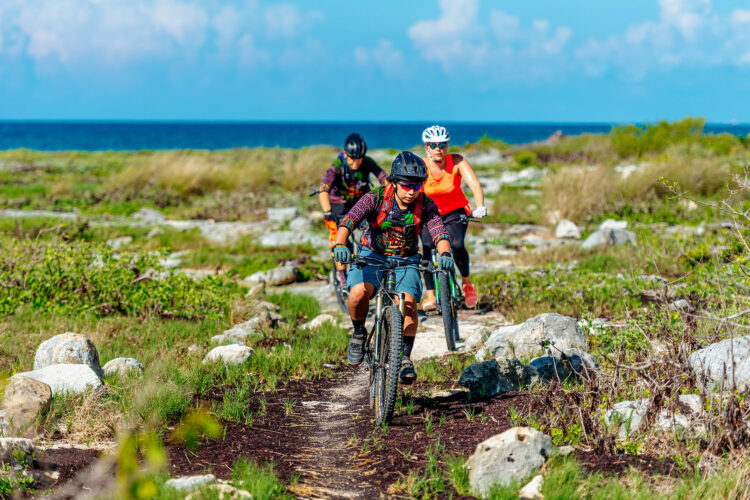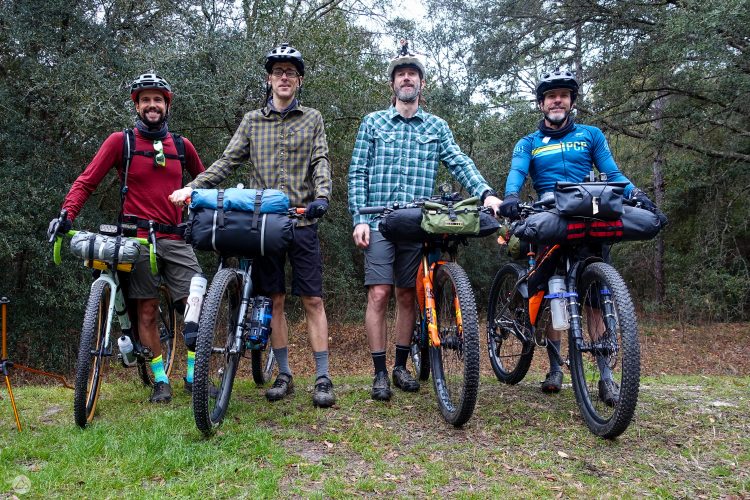
Near the latter part of our mountain bike tour through Ecuador with 2Wheel Epix, our bus turned down a narrow canyon road, walled by muggy rainforest. I watched the edge of the road creep toward the bus’s tires as we descended into the trees, around switchbacks, and closer to the rain-fed river below. Two days earlier, we were in Cuenca, Ecuador’s third most populous city with close to 300,000 people.
Our destination is known as Uzhcurrumi, and though I’m not sure how credible this site is, it claims the population in this village is about a thousand, which doesn’t seem inaccurate. Our bus stopped near the beginning of the town’s short strip of buildings. Dogs ran around the bus, and locals sat in front of their houses on plastic arm chairs watching the occasional vehicle pass by.
“We’re here,” said one of the 2Wheel Epix guides. “Uzhcurrumi.”
“We’re where?” the group wondered. In between the homes and small stores, appeared to be a restaurant. Hoisted above the restaurant is a billboard as big as a truck with a photo of a group of mountain bikers. Tucked behind the restaurant and layered into the mountainside is the hotel where we would stay. For the final two days of the trip, we planned to ride near the top of another mountain, above another village, Abañin.


Over the past four to five years, mountain biking has grown in Abañin, the small farming village on the mountain above Uzhcurrumi (pronounced ooz-choo-rumi), thanks largely to the efforts of Juan Jose Ugarte-Enriquez. Stores and restaurants in Abañin have become beneficiaries of the business. So has Uzhcurrumi.
The morning after we arrived, we were introduced to Juan Jose, who showed up with his driver in one of two unique shuttle vehicles, mid-size diesel pickup trucks with room for eight mountain bikers in the bed, four in the cab, and 10 bikes mounted above. Juan Jose is from Machala, a city an hour away. For generations his family business has been banana exports, and he owns a gym in Machala too, but he spends most of his weekends in Uzhcurrumi and Abañin developing the mountain biking scene.
I saddled up in the cab with Juan Jose on our way up the mountain to hear about how it all started. Before he was hooked on mountain biking, Juan Jose gambled.
“I was spending money like stupid,” he said. He’s soft spoken, but confident and humorous. “Now I prefer to spend my money on my bicycle and on the trails. But now, it’s too expensive to pay money on my bicycle… maybe I’ll go back to the casino,” he said laughing.
A friend first invited Juan Jose to ride cross country in the area. They would pedal the long mountain road from the valley up to Abañin, but it wasn’t his deal. The riding bored him and he’d rather test his mettle and have fun riding down the big mountains on singletrack. So he talked to the community of Abañin about using their trails. The singletrack is old. Some of it hadn’t been used in a long time and some of it is used regularly by community farmers, moving their cattle or produce; coffee, cacao, corn, and plantains.


Juan Jose explained that the community supported the idea as long as the riders supported the community. When mountain bikers visit Abañin, they should shop there too, and buy their chips, Gatorade, beer, or lunch at a store in the village or the mountains. He hired local trail workers for $25 a day to renovate and reopen some of the older trails. Springtime in Ecuador, as our American group learned, could be especially wet and the weather made it tricky to maintain or open the trails before May. They’ll close down again in the fall.
Before long, Juan Jose started an enduro race. The Uzchurrumi Enduro has had three editions so far. Last year they had about 90 athletes. This year, they’ll cap it at 150 racers. The race is different than traditional enduros. Racers need a good plan: rather than timing just the descents, the athletes are on the clock for all the stages in one day until they’re complete.
“So the race is blind, you can’t practice,” said Daniel Bascompte, one of the 2 Wheel Epix guides who has raced the enduro. “So you have to be super aware of your pace. And also you have to be aware that it’s a two day race. It’s not just one day. So you need to give your bike care — all the parts have to be good for the next day. So it’s another place that you have to take in this race. It’s more mental and strategic.”
A lot of athletes come from Guayaquil, Ecuador’s most populous city, and some come from Cuenca and Quito. Most plan to camp in Abañin and Juan Jose hires locals to prepare some of the meals for athletes. He says the design of the race forces people to make a strategy and plan out their best route.
“Some people like it, some people love it. Some people hate it,” he said. “You have to be smart.”
After 30 or 40 minutes driving up the mountain, we arrive in Abañin and stop in front of a mini-store and restaurant where we’ll have lunch later. We hopped out of the truck and bought Gatorades and snacks before the final drive to the top of the mountain. Chickens and dogs scampered around our feet in and out of sight. Someone hinted that we’d be eating one of the chickens later for lunch.
After filling up on snacks and another quick shuttle to the tippy-top of the mountain we unloaded our bikes, pulled up our knee pads, and turned on our GoPros; all the typical pre-ride checks when it comes to mountain biking on a Saturday somewhere in South America you never thought you’d be.

“Watch out for the cakes,” Juan Jose said. “The mines,” referring to the cow patties dotting the land. He pushed play on his bluetooth speaker and led us across a bumpy field to the start of the first trail as T.N.T. by AC/DC pumped into the mountain air. Two of the guys in our group had riding glasses with mini-speakers in the temples for musical motivation. While riding with bluetooth speakers in the U.S. might be contentious, Juan Jose saw it the other way. “Your music is only for you. My music is for everyone to enjoy,” he said with a smile.
The beginning of the trip — which we’ll share in an upcoming story — saw us covered in rain and mud. Abañin graced us with dry trails and our first run there was something else; tracing skinny singletrack down V-shaped switchbacks on another steep Ecuadorian mountain, surrounded by other steep, piercing mountains. Have to throw a foot down on the switchback? Juan Jose said we’d owe the group a beer.
Riding steep and wet trails the days prior gave me a bit more confidence for the steep and dry trails; go light on the front brake, use your rear tire as a rudder, and keep weight forward on your front tire so it doesn’t slip from in front of you.

Much of the singletrack around Abañin is pounded with hoof prints. It’s a reminder of whose mountain this really is. After crossing through a cattle gate, Juan Jose laced it closed again. Escaped cattle can cost local farmers a small fortune. Produce and livestock are not only how residents generate an income, it’s how they feed themselves and their neighbors too. A middle class income in Ecuador is reportedly around $1,400 a month, but poorer citizens might live off as little as $200-400 a month. A cow costs between $800-$1,000.
After a few laps, we returned to the mini-store and restaurant for lunch, beer, and a red liquor called caña de Jamaica that went down like liquid sandpaper. The locals laughed after I gulped it down thinking it was more Gatorade. Lunch was typical for Ecuador: rice, lentils, chicken (possibly the one walking around earlier), sweet caramelized bananas, and salty corn cakes.

After a late lunch, we decided on a sunset lap, and closed out the second-to-last day of riding descending above the pillowy clouds and warm sun. The trail was rough, but damp, and hard to pay attention to considering the sunset.

The next morning marked our last day of riding in Ecuador. Our group made amends with this fact quickly. Though incredible, our arms were sore, our knees banged up, and our stomachs were in dire need of a burger. Our 9am departure turned into 10am, and slowly we piled in the back of the pickup trucks and blasted up the mountain road.
Three short laps and one long one was on the agenda. The downhill runs were only about a mile or two long, but shuttling up and around the mountain took time. We met up with some locals who we rode with the day before.
Gabriel Ugarte, a buttoned-up lawyer who trades his suit and tie for Troy Lee downhill gear on the weekends, joined us for both days. He lives in Machala, a city of about a quarter-million. I followed him again down the surfy singletrack, still trying to steer around turns without putting my foot down.
On our second run of the second day, we shuttled up to the top of one peak and descended about 1,400 feet in just over two miles, and hiked out of the gut of a valley, back to the shuttle. A motorcycle leaned against a tree, and 50 yards away a farmer sat on a rock, still as a stone, and held a big stick, watching his cattle pick at the grass. I envied his peace. It was something I traveled to another continent in search of, even if it was just a sliver.


At lunch, the group started splitting up. Some of us still felt the stomach bug from earlier in the week. Half of us wanted to skip the last long lap — a 45-minute singletrack descent heading toward Uzhcurrumi — and take the mountain road. The other half wanted the whole enchilada, no matter how painful it was to finish. I chewed on it, made my mind, and then re-made my mind.
“It’s the last time I’ll probably ever mountain bike in Ecuador,” said Jack, a university student from Utah who had suffered from stomach problems for four or five days by then. “Gotta do it.”
The trail was steep — no surprise there — and one of the rockiest we’d done since being in the country. I struggled weaving my long bike through the pinched switchbacks, and offered a local an opportunity to pass. “It’s OK! It’s OK!,” he said. Anytime I thought they might get impatient with me, they stopped and waited with a smile on their face.
Like clockwork, around 45 minutes later, we popped out of the jungle, onto a wooden suspension bridge, and crossed the Jubones River. The fastest racers in the Uzhcurrumi Enduro make it down the trail in under twenty minutes.

Steve, a business owner from Utah, bought a tall Ecuadorian pilsener at the roadside tienda and poured us some celebratory beers before we hopped back in the trucks to the hotel.
The next morning, we packed our bags and rolled them up the walkways to the main level of the hotel and onto the street to the bus. I couldn’t stop thinking about pancakes. And air conditioning. And hamburgers. And a warm shower.
Our bus chirped up, and lurched onto the bumpy road, potholes full of standing rainwater. We looked out the window. The locals sat in their plastic arm chairs, gave us their blessing, and watched us roll by.











1 Comments
Jun 22, 2022